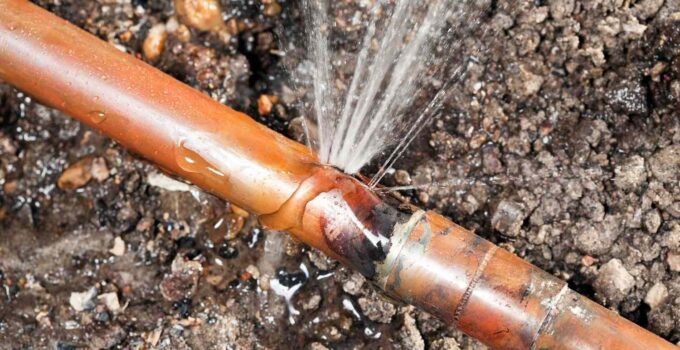As a homeowner, one of the most daunting challenges you can face is dealing with plumbing issues, particularly those that are not immediately visible, like an underground pipe burst. Such a situation not only disrupts the daily routine but can also lead to significant damage and expense if not addressed promptly. Understanding the signs of an underground pipe burst and knowing how to respond is essential. This article aims to equip homeowners with the knowledge to identify, address, and prevent these hidden plumbing disasters, ensuring the integrity and safety of their homes.
Early Detection of Pipe Burts
Detecting an underground pipe burst early is crucial for homeowners to avoid extensive damage and costly repairs. The challenge lies in the fact that these pipes are not visible, and the problem often goes unnoticed until significant damage has occurred. Understanding the early signs of a burst pipe can save you from a potential disaster. Being vigilant about changes in your home’s plumbing system, listening for unusual sounds, and monitoring bills are key practices in early detection. Check out these plumbing tips for more on early pipe burst detection.
Sudden Spike in Water Bill

Source: freepik.com
One of the most obvious signs of a pipe burst is an unexpected increase in your bill. This can often be the first indication that something is amiss. A sudden spike in usage, when your daily habits haven’t changed, suggests that water is being lost somewhere in the system. Monitoring your bill is a simple yet effective way to keep tabs on your plumbing’s health. It’s important to compare current bills with those from the same period in previous years to identify any unusual patterns.
Changes in Water Pressure
Another clear indicator of an underground pipe burst is a noticeable drop in pressure throughout your home. This symptom can range from subtle to severe. When a pipe bursts, water that should be flowing to your faucets and appliances leaks into the surrounding soil instead, leading to a decrease in the pressure with which water flows in your home. Paying attention to how your showers and faucets perform can provide early clues to potential problems.
Wet Spots and Soggy Patches in the Yard
Wet, soggy patches in your yard, particularly during dry weather, can be a sign of an underground pipe burst. These patches might be localized to a particular area, indicating the potential site of the leak. The soil may appear unusually soft, and you might notice an unexpected growth of grass or plants in the area, fueled by the excess water. It’s important to inspect your yard regularly, especially areas above where your main lines run.
The Sound of Running Water When All is Quiet

Source: freepik.com
Paying attention to the sounds in your home can also help detect a pipe burst. The sound of running water when all taps and water-using appliances are off is a critical indicator. This sound might be faint and more noticeable during quieter times, like at night. It’s wise to occasionally turn off all distractions and listen carefully for any sounds of running water.
Unexplained Cracks in Foundation or Walls
While less common, the appearance of cracks in your home’s foundation or walls can signal a serious underground pipe burst. Escaping water can wash away soil, undermining the structural integrity of your home. This can lead to visible cracks and even cause doors and windows to stick or not close properly. Regularly inspecting your home for structural changes is an important part of identifying a pipe burst.
Damp or Musty Odors
Sometimes, the signs of a burst pipe are not visible but olfactory. Damp or musty odors in your home, especially in areas like basements, can indicate that water is accumulating underground or within walls. These odors are caused by moisture that has no way to escape or dry out, often leading to mold and mildew growth. If you notice persistent musty smells, it’s worth investigating further for potential plumbing issues.
Fluctuating Water Meter Readings
Your meter can be an invaluable tool in detecting a pipe burst. When all outlets are turned off, your meter should remain static. If the meter continues to change, it indicates that water is flowing somewhere in the system. Regularly checking your meter, especially after turning off all water sources, can provide a clear indication of hidden leaks.
Discoloration in Water Supply

Source: freepik.com
Sometimes, a pipe burst can cause dirt and debris to enter your water supply, leading to discoloration. If you notice brown, yellow, or cloudy water coming from your faucets, it could be a sign of a damaged pipe. It’s important not to ignore changes in water quality, as they can indicate serious plumbing issues.
Temperature Fluctuations in Water Supply
An underground pipe burst can also lead to fluctuations in water temperature. If you start experiencing inconsistent water temperatures, or if your hot water supply is suddenly less reliable, it could be due to a compromised pipe. This is particularly true if these changes occur without any adjustments to your water heater settings.
Preventive Measures and Regular Maintenance
Preventing an underground pipe burst is often easier than dealing with the aftermath. Regular maintenance of your plumbing system, including professional inspections, can help identify potential issues before they escalate. Being proactive about the health of your plumbing can save you from the headaches and expenses of dealing with a major pipe burst. Regular checks, timely repairs, and understanding the layout of your plumbing system are key strategies in prevention.
Closing Thoughts
In conclusion, being vigilant about the health of your plumbing system is crucial for any homeowner. By understanding and recognizing the signs of an underground pipe burst, such as unexpected spikes in the water bill, changes in water pressure, wet patches in the yard, and the sound of running water, you can take swift action to mitigate damage. Regular inspections and maintenance of your plumbing system are key to preventing such occurrences. Remember, addressing a plumbing issue early can save you from the extensive damage and high costs associated with major repairs.







